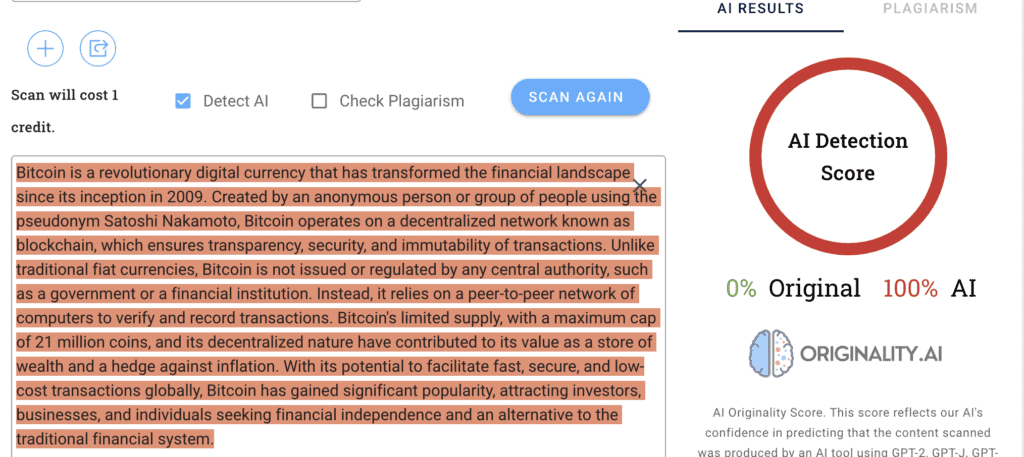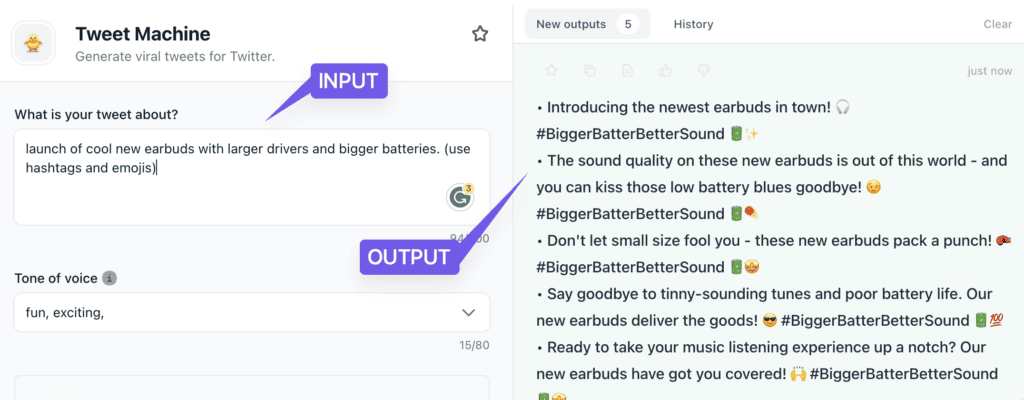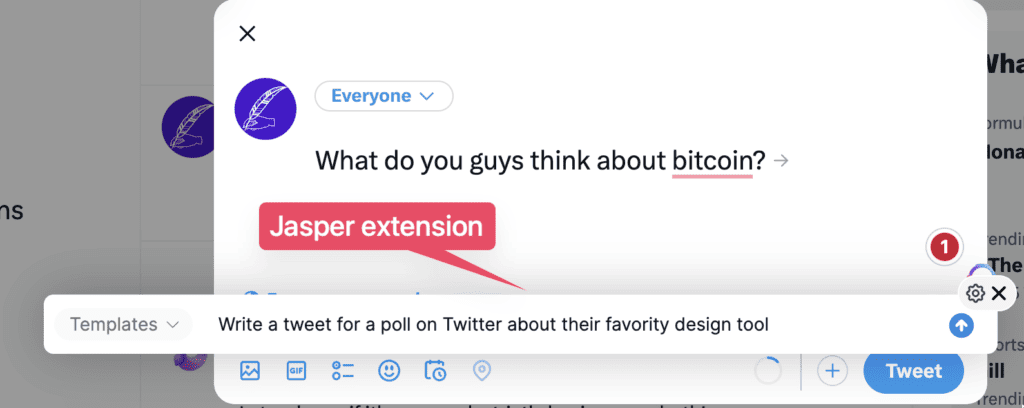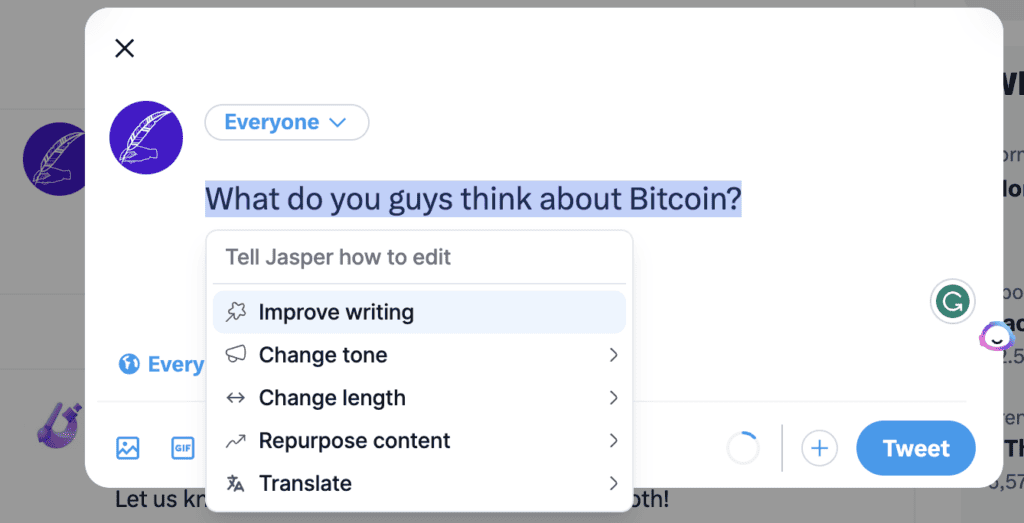If you are in the market for the best AI writing tool, this ultimate guide will make it easier for you to decide how to choose one.
With the rise of the popularity of ChatGPT, the market has been flooded with tons of AI writing tools, but, not all tools are made equal.
Some tools are truly great and check all boxes, others are just average and a few are outright no-nos.
In this comprehensive AI writer buyers guide, I will lay down a few factors you should consider before buying an AI writing tool.
Note: In this article, I will use the terms AI writer, AI writing tool and AI writing assistant interchangeably. They all mean the same thing.
Let’s get started.
- AI Writing Tool Buying Guide (Essential features)
- 1. Language Model (GPT-4 or 3.5 is a must)
- 2. Ability to pass AI-detection test
- 3. Templates
- 4. Document editor for long-form writing
- 5. AI Chatbot for flexibility
- 6. Integration with other tools
- 7. Browser Extension
- 8. Content type
- 9. AI art generator
- 10. Unlimited words
- 11. Languages Support
- 12. Pricing
- Conclusion
AI Writing Tool Buying Guide (Essential features)
In this section, you will learn what to look for in an AI writer.
1. Language Model (GPT-4 or 3.5 is a must)
AI writing tools source their data from a database called Large Language Models (LLMs). These models are trained with a huge amount of data available online. Some companies like Jasper.ai claim that their AI tools have read and analyzed nearly 10% of the Internet.
The more data an AI tool has been trained on, the better it becomes at understanding user commands and providing a coherent response.
GPT-3.5 and GPT-4 are some of the largest language models and are far superior in their ability to comprehend user input and putting together a coherent, logical output.
Just for your information, some other language models in market are T-5, GPT-Neo, Bloom, PaLM 2 & RoBERTa (from Google). GPT-3.5 and GPT-4 from OpenAI trump all of them.
Language models are probably one of the most important factors because it directly impacts the quality of output.
ChatGPT made such big splashes in the newspapers because the language models it uses (GPT-3.5 and 4) are so good at producing quality content.
If your AI writing assistant produces crap that you have to spend a lot of time correcting and editing, it’s useless and counterproductive. Instead of spending time editing it, you might as well write the entire content by yourself.
Therefore anything less than GPT-3.5 is a strict no-no. GPT-3 is utter crap in comparison to GPT-3.5 and 4.
There are tools such as Jasper.ai, Writesonic, and TextCortex that use GPT 3.5 or higher.
2. Ability to pass AI-detection test
AI tools leave their quirks or signature in the content they produce. Things like sentence length, word sequences, vocabulary clusters, paragraph structure, and length can be considered the traces of an AI tool.
These AI traces can be picked up by AI detection tools such as Originality AI (and by Google too!).
For example, ChatGPT’s content is almost always flagged as AI, which makes it unsuitable for blogging (and assignments!)

If you are writing a blog post or an assignment, you don’t want it to have any detectible AI traces. It’s not only bad for SEO, it also impacts your credibility. Users (and Google) might think that you don’t have any first-hand experience with your subject matter.
That’s why users rely on text spinner tools like Quillbot to paraphrase the AI text and fool AI detection tools.
But wouldn’t it be better if your AI tool didn’t put its watermark in the content in the first place?
I have tested a lot of tools for their AI detection capabilities but none came closer to Jasper AI. It manages to evade AI detectors about 50% of the time. That’s because it uses about 5 to 6 language models (in addition to GPT-3.5) and intelligently switches between them depending on your query.
So, if AI-detection-free content is your priority, you should definitely check out Jasper.ai.
3. Templates
Templates are prebuilt content blocks, that produce output suitable for a particular scenario.
For example, the Tweet generator template will spit out only tweets, the Blog article generator will produce only blog posts and the Outline template will only produce an outline for your blog title.

Templates are pretty easy to use too: you just feed them some input, click generate and you get the output.
There are around 30 templates that are a must-have but some marketers are trying to grab eyeballs by claiming up to 130+ templates.
Don’t fall for the hype. Most of the extraneous templates are flimsy and not really useful. They seem to have been inserted as a marketing gimmick.
Some of the essential templates are:
- Blog post outline
- Blog post generator
- FAQ Generator
- Listicle generator
- Google and Facebook Ad copywriter
- Tweets/Instagram captions/Facebook post generators
- Features to benefit converter
- Linkedin post generator
- Rewriter, summarise, paraphraser, expander, Tone-changer
All major tools come with over 50+ essential templates, so, fortunately, you don’t have to worry on this front.
4. Document editor for long-form writing
Templates are good when you want a predictable kind of output but they lack flexibility.
You can’t edit the output or influence the intermediate steps of content generation in any way. If you want to modify the output, you have to copy the template output and paste it into the editor.
Also, if want to write long-form content, such as “ultimate guides” or ebooks, you need a dedicated AI-powered document editor.
These document editors have several AI features which make them capable of doing some cool things such as writing content based on the context, expanding a sentence to a paragraph, summarising the text, or creating FAQs based on your content so far.
Some tools like Jasper.ai and Copymatic also come with the ability to predict your next sentence.
5. AI Chatbot for flexibility
Templates are rigid. There’s so little you can do with them outside of their predefined structure.
ChatGPT like chatbots overcomes the limitations imposed by templates. You can literally ask an AI chatbot to write content for any platform in any format, and the chatbot will write that.
For example, I haven’t found any template in any AI tool which produces data in the table format but you can ask the chatbot to produce data in a table.
AI chatbots also come with the ability to connect to the internet. They can collate data from the Internet in real-time and compose answers with proper source citations.
6. Integration with other tools
AI writing tools are great on their own but are more useful when they are paired with other tools that boost your productivity.
Here’s a list of a few common tools that are integrated with AI writing assistants:
Surfer SEO
If you are using your AI tool to write blog posts, integration with Surfer SEO is going to be super helpful.
Surfer SEO scans all the first 10 results on Google’s first page for a keyword and identifies related keywords and phrases that fall under the same cluster. This way, you know which words/phrases to include (and how many times!) in your blog post to get better visibility in search results.
Tools like Jasper.ai, Writesonic, Textcortex, and Longshot come with built-in Surfer SEO integration. Remember that Surfer SEO is another paid program, so you will have to buy its subscription separately.
Plagiarism detector
With using AI writer tools, there is always a chance that the content produced is plagiarised or picked up verbatim from an external source.
To counter this mishap, some AI writers come equipped with an external, independent plagiarism detector such as Copyscape.
Copyscape takes your content and scans it with billions of documents and web pages for any signs of plagiarism.
The integration of an AI writer with a plagiarism detector makes it frictionless to scan your text for plagiarism, without leaving your place or switching browser tabs.
Tools like Jasper.ai, Writesonic, and Copymatic come integrated with a plagiarism checker.
WordPress Integration
If you are buying an AI writer for blogging, you will appreciate the tools that come with WordPress integration.
AI writers having a WordPress plugin make it seamless for you to pull data directly from the AI assistant’s database, without you having to manually copy and paste it into the WordPress editor.
Tools like Longshot.ai, Copymatic, and Markcopy.ai come with WordPress integration enabled.
Grammarly
Grammarly is a grammar-checking tool. It automatically checks your text for any grammatical and stylistic mistakes and suggests corrections.
By default, you get its free version with AI writing tools but even if your AI writer doesn’t integrate with Grammarly, it’s not a dealbreaker.
You can simply install the free Grammarly Chrome extension and it will work just fine.
7. Browser Extension
You don’t write just in one place nowadays. You write everywhere: emails, social media, Twitter, Instagram, comment sections, and more.
It would be a pain in the arse if you had to switch to your AI writing tool every time you are writing anywhere on the web.
Wouldn’t it be great if you could use the AI tool everywhere? That’s where browser extensions come in.
Many AI tools have their own browser extensions that pop up whenever you click a text box.

You can quickly give these extensions commands or simply copy a piece of text, and it will offer you several options such as rewrite, expand, summarize, shorten, or improve.

This browser extension makes the entire online writing experience so smooth and convenient that it is difficult to imagine web browsing without it.
Almost all popular AI writers such as Jasper.ai, Textcortex, Wordtune, Writesonic, and Copymatic come with a browser extension with varying capabilities.
8. Content type
Some AI tools are geared toward particular content types.
For example, Jasper.ai is great for blogging and most other forms of writing, Copy.ai is targeted at Copywriters, Longshot is great for writing long-form blog posts, Frase.io is focused on writing SEO-optimized articles (using keyword clusters), ArticleForge and ContentBot.ai are good for pumping out articles in bulk and Quillbot is aimed at paraphrasing AI content.
The content type that an AI tool is optimized for is also factored into its pricing model. Therefore it becomes crucial that you choose a tool that fulfills your needs most so that you don’t have to pay for features you don’t use.
9. AI art generator
With the popularity of AI writers, AI art generators have also become widespread.
Some AI writers bundle an AI art generator in their plan with the capability to generate unlimited images.
Jasper.ai and Inkforall give you the option to generate unlimited images whereas Writesonic deducts 100 word credits for every image you generate.
10. Unlimited words
AI writing is a new technology. A lot of the time, these AI tools don’t produce the desired or intended output the first time. You might need to run your command and variations multiple times to get exactly what (and how) you want it to write.
All in all, I have observed that only about 20-30% of the output of AI is usable. The rest has to be either discarded or edited out.
It, therefore, makes sense to buy an AI writer which gives you unlimited words for a fixed monthly price. This way, you don’t have to constantly watch out for remaining credits and you have more freedom for experimentation with different commands and prompts.
Several tools such as Jasper.ai, Copy.ai, Copymatic, and WordHero offer you unlimited words for a monthly fee.
11. Languages Support
Most GPT-based tools support over 25 languages. Usually, these tools come with some kind of AI translator such as ‘DeepL’ to translate text between languages.
Remember that most of the language models are trained with content in the English language. For example, the largest language model GPT-4 from OpenAI was trained on data, 92% of which was in English.
If you are blogging in a language other than English or if your writing needs involve writing content in non-English languages, you might want to check the languages supported by these tools.
12. Pricing
Pricing of course matters when buying an AI writer.
Almost all AI writers are subscription based where you pay a monthly fee to use its features.
AI writers come in a range of prices. The cheapest one is Rytr ($9/month), followed by Writesonic ($19/month), Textcortex ($24.99/month), and Copymatic ($29/month).
At the other end are Jasper.ai ($49/month), Copy.ai ($49/month), and TextCortex’s Business version ($79.99/month).
These prices are for monthly plans. If you buy annual plans, you will get discounts ranging from 20% to 50% depending on the AI writer. So, be sure to check them out.
Conclusion
I hope you found this AI writer buying guide helpful.
Remember, the more features you need, the expensive the product will be. So, be sure to curate what’s important for you and then take the call.
Here’s a list of AI writers which you might find helpful.
Thanks for reading.